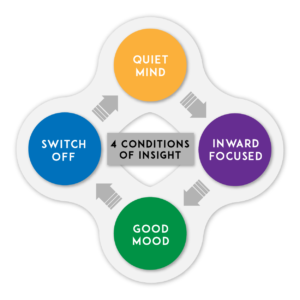In the following blog from Mary Maddock, her insights about insight are applicable to learning the Enneagram, discovering type, training, coaching, consulting, problem solving, and more!
Think about a time when from nowhere, you had a moment of brilliance – an aha or lightbulb moment. Where were you? What were you doing? What did it feel like?
When I ask people about their aha experience, most commonly, they say it happens when they least expect it – taking a shower, walking the dog, listening to music, or just as they are waking up from sleep – that is, when they are not thinking about the problem.
An aha moment or insight, has two distinct characteristics – with a burst of brain energy the solution comes to you suddenly as a new breakthrough thought, and, instinctively you know the solution to the problem is right.
Whilst insights might feel they are random, they are not. The brain is following some predictable processes. Although it is unlikely that we can predict when you will have an insight, you have the ability to foster more of them, if the conditions for the brain are right.
Neuroscientists studying Aha moments have revealed there are four conditions that significantly increase the likelihood of stimulating insights.
Quiet mind
By having a quiet mind, your brain activity level is low, this allows “weak” signals in the brain to be heard, enabling the brain to make new connections by drawing together distantly related information. “Insights require a quiet mind because they themselves are quiet.” (Rock 2011)
Inward focused
Our attention at any one moment is externally focused. When you focus your attention inward and without the usual day to day distractions, can support the brain by putting into idle mode. This allows the brain to wander and access deeper thinking.
Good mood
Putting pressure on solving a problem can induce anxiety in the brain, which limits or narrows your perspective. Feeling slightly positive, alters your brain activity to take in a wider range of information which in turn can bring forward new thinking.
Switch off
Stop thinking about the problem is counter intuitive to how we have traditionally learnt to find a solution. Known as the incubation period, the brain continues to “work on things’ non-consciously and when you focus on unrelated or undemanding tasks, by letting the brain go, it does the work for you. In effect, the brain is simmering to solve.
Given insight is a brain friendly way to solve complex problems, how can you create the conditions to have more of them?
Mary Maddock is a coach, trainer, consultant and facilitator from Melbourne, Australia
e-mail: mary@leadershiftpathways.com.au | website: leadershiftpathways.com.au
Ginger Lapid-Bogda PhD, the author of seven best-selling Enneagram-business books, is a speaker, consultant, trainer, and coach. She provides certification programs for professionals around the world who want to bring the Enneagram into organizations with high-impact business applications, and is past-president of the International Enneagram Association. Visit her website: TheEnneagramInBusiness.com. ginger@theenneagraminbusiness.com


Comments are closed.